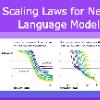This paper investigates discrepancies in how neural networks learn from different imaging domains, which are commonly overlooked when adopting computer vision techniques from the domain of natural images to other specialized domains such as medical images. Recent works have found that the generalization error of a trained network typically increases with the intrinsic dimension ($d_{data}$) of its training set. Yet, the steepness of this relationship varies significantly between medical (radiological) and natural imaging domains, with no existing theoretical explanation. We address this gap in knowledge by establishing and empirically validating a generalization scaling law with respect to $d_{data}$, and propose that the substantial scaling discrepancy between the two considered domains may be at least partially attributed to the higher intrinsic ``label sharpness'' ($K_\mathcal{F}$) of medical imaging datasets, a metric which we propose. Next, we demonstrate an additional benefit of measuring the label sharpness of a training set: it is negatively correlated with the trained model's adversarial robustness, which notably leads to models for medical images having a substantially higher vulnerability to adversarial attack. Finally, we extend our $d_{data}$ formalism to the related metric of learned representation intrinsic dimension ($d_{repr}$), derive a generalization scaling law with respect to $d_{repr}$, and show that $d_{data}$ serves as an upper bound for $d_{repr}$. Our theoretical results are supported by thorough experiments with six models and eleven natural and medical imaging datasets over a range of training set sizes. Our findings offer insights into the influence of intrinsic dataset properties on generalization, representation learning, and robustness in deep neural networks. Code link: https://github.com/mazurowski-lab/intrinsic-properties
翻译:暂无翻译




